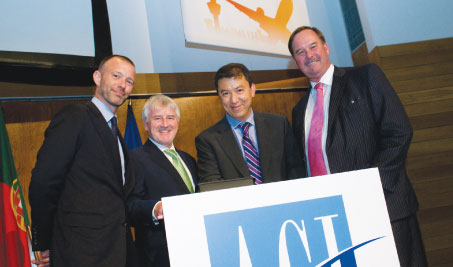
Olivier Jankovec, Director General, ACI EUROPE; Declan Collier, CEO, Dublin Airport Authority and ACI EUROPE President; Patrick Ky, Executive Director of the SESAR Joint Undertaking; and Ad Rutten, Executive Vice-President and COO, Schiphol Group and former ACI EUROPE President.
The SESAR programme was founded by the European Commission and EUROCONTROL in 2004. It is comprised of three phases:
- Definition phase (2004-2008) – to deliver an Air Traffic Management (ATM) master plan defining the content, development and deployment plans of the next generation of ATM systems.
- Development phase (2008-2013) – to produce the required new generation of technological systems and components as defined in the Definition phase. This phase, with a budget of €2.1 billion, is managed by the SESAR Joint Undertaking.
- Deployment phase (2014-2020) – for production and implementation of the new air traffic management infrastructure, composed of fully harmonised and interoperable components which guarantee high performance air transport activities in Europe.
SESAR represents the technological dimension of the Single European Sky initiative, and is designed to provide a high-performance air traffic control infrastructure, enabling the safe and environmentally friendly development of air transport. By 2020, it aims to generate average savings per flight of 8-14 minutes, 300-500kg of fuel, and 948 to 1,575kg of CO2. SESAR will eliminate the fragmented approach to European ATM, transforming the ATM system and synchronising all stakeholders. Significantly, all aviation stakeholders are involved in the Definition, Development and Deployment of this pan-European modernisation project.
“SESAR is set to modernise air traffic management in Europe. Recent projections predict for Europe a doubling of flights by 2030 compared to 2009 levels. This equals 16.9 million movements; everybody knows that the current air traffic management system cannot cope with such an increase. SESAR is prepared to address this challenge,” commented Patrick Ky, Executive Director of the SESAR Joint Undertaking.
Technical expertise
The key objective of the SESAR Joint Undertaking is to ensure the modernisation of the European air traffic management system by coordinating and concentrating all relevant research and development efforts in Europe. Under the cooperation agreement, ACI EUROPE will be involved in various research projects, development and communications activities, specifically focused on the role and contribution of airports in SESAR. The agreement builds on the work of the Single European Airports Consortium (an established group of airports participating in SESAR comprised of Aéroports de Paris, BAA, Flughafen München, Fraport, Amsterdam Schiphol and Flughafen Zurich) and is designed to yield a better engagement and integration of the entire airport community into the SESAR JU’s work, with the aim of increasing the efficiency of the European aviation system.
Olivier Jankovec, Director General, ACI EUROPE, said: “We are delighted to be joining forces with the SESAR Joint Undertaking. SESAR is the technological enabler of the Single European Sky and this cooperation reflects a strong focus on integrating airports within the ATM system. Much of SESAR’s work involves airports and many of our member airports are already engaged, with significant investments in the SESAR programme, to help optimise airport operations for the benefit of airlines and passengers today and tomorrow.”
Ky added: “Our collaboration with ACI EUROPE will undoubtedly bring more technical expertise on airport operations and open doors for validation in day-to-day activities. Airports are a key contributor to SESAR and one of the beneficiaries of the SESAR results. SESAR will maximise capacity and bring better operations on the ground and in the air, as well as environmentally friendly solutions for airport operators; clearly vital to every single European airport.”
Partnership, sustainability and user-drive are key concepts of the SESAR Joint Undertaking approach, and this partnership approach is evident through the cooperation agreement with ACI EUROPE.
The SESAR Master Plan – outlining which, where and when technologies are needed – is being updated. Meanwhile, the first SESAR ‘Release’ will take place by the end of 2011 – this will contain 29 validation exercises conducted by SESAR members across Europe, which are aimed at providing improved ATM solutions. Exercises cover efficient airspace operations, end-to-end traffic synchronisation and integrated and collaborative network management.







